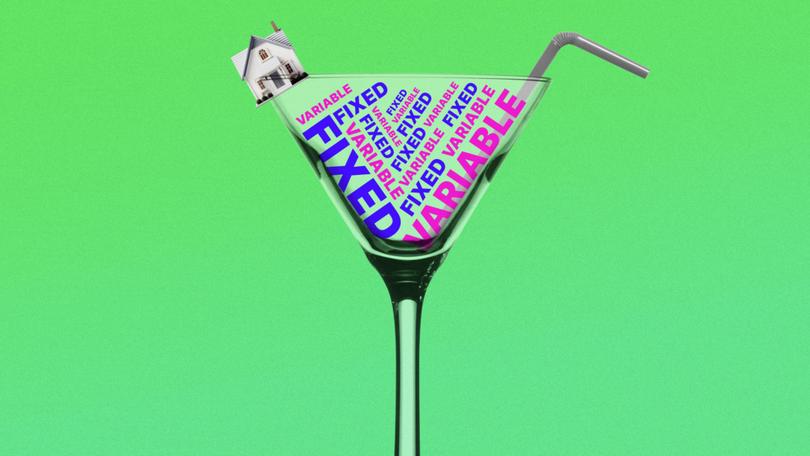DAVID KOCH: The risks and rewards of a split loan — fixed and variable — in uncertain interest rate times

Australians have the highest proportion of variable home loans in the world. But is it time to switch to a fixed rate loan or a cocktail of fixed and variable?
I know that sounds crazy when there is huge anticipation for a cut in interest rates from the Reserve Bank on the horizon. But given the difference between variable and fixed rates plus a growing doubt about the timing and size of a future cut, fixing could be a consideration.
In the latest RBA board minutes, it was made clear that there would be no rate cut until two consecutive quarterly CPI results landed with the 2 to 3 per cent target range. When we talk about CPI results we’re not talking about the “headline rate” (which is already in the target range) but the trimmed mean, which strips out any one-off variations in prices caused by things like Government incentives. That figure is still well above 3 per cent.
Sign up to The Nightly's newsletters.
Get the first look at the digital newspaper, curated daily stories and breaking headlines delivered to your inbox.
By continuing you agree to our Terms and Privacy Policy.Wednesday’s monthly CPI is a great example. The headline rate came in at 2.1 per cent because of a 12.3 per cent drop in power prices (down 35.6 per cent for the year) because of the Federal Government’s energy bill relief, plus extra rebates from the Queensland and WA State governments.
Strip those artificial sweeteners out and the trimmed mean CPI actually rose for the month from 3.2 per cent to 3.5 per cent. So, through the eyes of the RBA, inflation is getting worse rather than better using its filter.
If you assume the September quarter CPI was not a good result in the eyes of the RBA, it would need a good result in the December and March quarters before it’d consider cutting rates. The March quarter CPI result is released on April 20 and the RBA meets on May 19 and 20 next year, a week before the deadline for the Federal election.
There is a very good chance we won’t get a rate cut before the next election, even if it is held late. That’s why the Treasurer is getting so aggressive in sprouting the Government’s economic credentials.
Let’s assume there is no rate cut until at least May, almost six months away. Currently the average variable home loan rate is 6.3 per cent but there are some two and three year fixed rates as low as 5.59 per cent. That’s almost a 0.75 per cent difference, or three RBA cuts.
Analysis by comparison website Compare The Market shows a borrower with a $500,000 split loan could potentially reduce their repayments by $4104 over the first three years if the cash rate were to remain unchanged.
Even if the Reserve Bank were to drop the cash rate twice by a total of 0.5 per cent, borrowers would continue to pay less on their fixed portion at a rate of 5.59 per cent. Only after a third 0.25 per cent rate cut would the average variable rate beat the split loan option for savings.
The reality is, we don’t know if, or when, rates will drop but it’s hard to find variable rates below 6 per cent.
Interest rate forecasting has become a financial sport and there are plenty of experts who have egg on their face at the moment. Remember six months ago when the major banks were predicting at least one, maybe two, interest rate cuts by the end of 2024? Hasn’t happened.
Inflation hasn’t slowed as expected thanks to a combination of rent, building costs, insurance premiums and wage rises feeding into the services sector. These are the “sticky” cost increases holding up the inflation rate and holding up the RBA from rate cuts.
Now there is the election of Donald Trump as US president and his inflation boosting policies of increasing tariffs and mass deportations of illegal immigrants. There is a fear these types of policies will see a spike in US inflation, which could be exported overseas, meaning the Federal Reserve will need to curtail future rate cuts.
This increasingly uncertain inflation and interest rate outlook is why the difference between variable and fixed rate home loans is interesting.
A hybrid approach allows borrowers to hedge their bets and experience the benefits of both rate types. Just remember you’re also exposed to the risks.
Fixed rates are great for shielding you from rate rises but if the cash rate happens to fall, you may miss out on savings.
Choosing a split loan depends on individual needs, circumstances, financial goals, and risk tolerance. Before making any decision, I’d encourage prospective borrowers to talk to a home loan specialist to better understand their options.
David Koch is the economic director at Compare the Market
